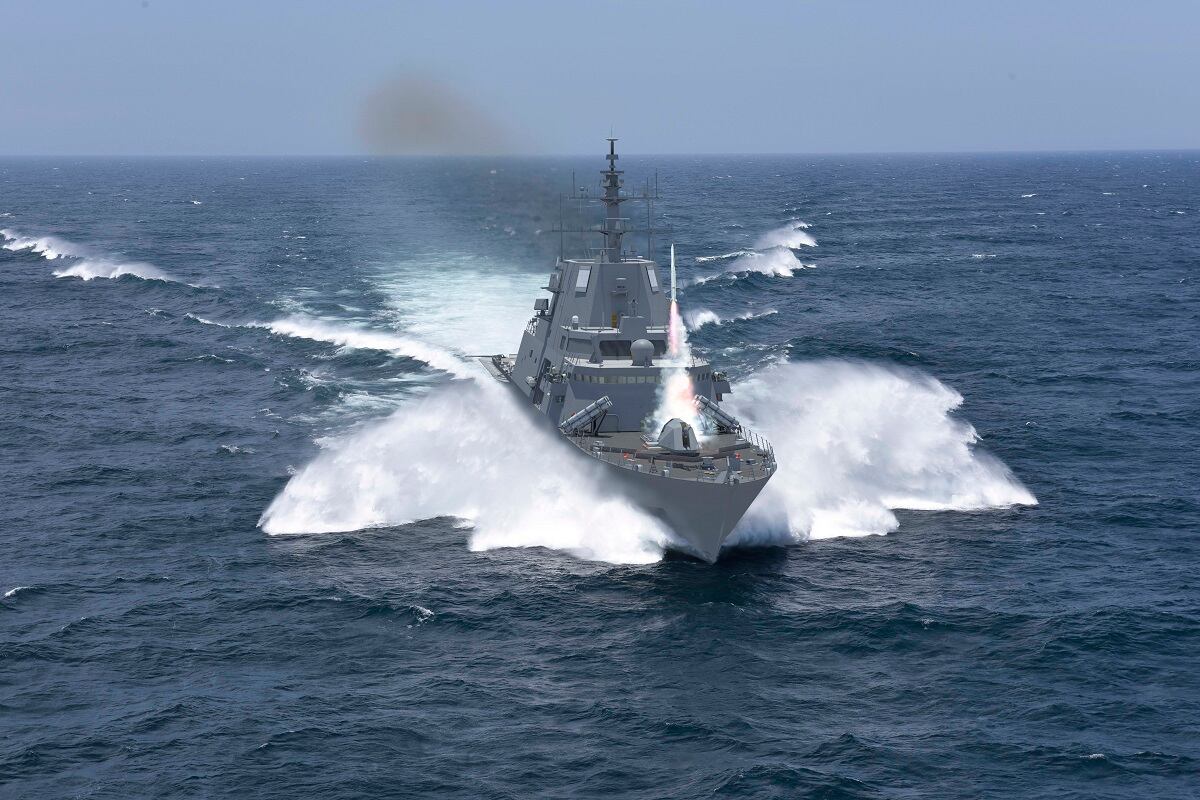ABU DHABI — The days of dramatic pictures of ships launching sideways into the water at Marinette Marine shipyard in Wisconsin are likely coming to an end, a representative from Fincantieri’s international ship business told Defense News on Tuesday.
As part of investments Fincantieri is making in the yard ahead of building an up-gunned frigate version of Lockheed Martin’s mono-hull variant of the littoral combat ship for Saudi Arabia, the company is investing in a modernized boat-launching facility that gently floats the ships rather than dropping them sideways into the water.
“It’s certainly romantic, it’s nice looking, but from our point of view it is not the best,” said Enrico Bonetti, a senior vice president at Fincantieri’s international business unit. “So we need to have much more advanced outfitting at the moment of launch. We’ll have a less dramatic way with a syncrolift.”
But while the shipyard is primarily focused on the four Saudi multimission surface combatants at Marinette Marine, another, larger prize is on the table: a 20-ship (and perhaps more) program for the U.S. Navy’s future frigate.
RELATED

When the Navy announced last year the top five competitors for the FFG(X) future frigate program, it was readily apparent that Fincantieri’s Marinette Marine was in a good position to grab a healthy slice of the business. Both the Lockheed Martin LCS variant and Fincantieri’s own bid — its European multimission frigate FREMM — would be built at Marinette, meaning that Fincantieri essentially has two of the five top choices.
The work that Fincantieri is putting into the yard will help position the company in the competition, which is slated to kick off this summer after the Navy finishes up its last series of design reviews with the top five competitors.
“We’re going to integrate the yard with new facilities,” Bonetti said. “First, we’ve put a huge amount of money into the yard to make it, what I would say, is the most modern shipyard facility in the United States. You can’t recognize the yard now from what it was a few years ago. But due to the size of FFG(X) and, mainly, due to the added workload for MMSC, we needed to improve our capacity. So it’s something that is already underway.”
The competition itself will be open to all comers, but anyone — such as BAE Systems’ Type 26 — who might want to join the hunt would not have had the benefit of a back-and-forth with the Navy’s requirements professionals that the top five competitors had over the past year in the initial conceptual design phase.
The Navy is planning to buy the first FFG(X) in the fourth quarter of 2020.
Until then, Fincantieri is focusing on what it must do to get moving on Saudi’s new frigate, though the contract has yet to be finalized.
“The contract is secured, we’ve been funded for design activities and long-lead item procurement, but the exact figure will be defined and agreed upon next summer,” Bonetti said. “So this is for us something that is quite important, it will provide the bread and butter for the yard for quite some time.”
RELATED

The plan for FFG(X)
As for the U.S. Navy’s part, it feels good about the process it undertook to quickly get a new frigate to the fleet.
The service is zeroing in on a cost and the shape of its new frigate as it prepares to launch the competition.
Through the conceptual design phase, which kicked off last year, the Navy asked for feedback from the five competitors in the competition. The result was more than 300 suggestions for ways to evolve the design and save money, Naval Sea Systems Command’s FFG(X) program head, Regan Campbell, told an audience at the annual Surface Navy Association Symposium. About 200 of the suggestions the Navy took onboard.
“Our requirements are mature,” Campbell said. “We’ve engaged with industry, gotten a lot of wonderful feedback and significant savings from that engagement. And we are on track to finish those conceptual design contracts, and through that process I think we are going to have a robust competition going into detailed design and construction.”
The five designs participating in the conceptual design phase are variants of Lockheed Martin’s mono-hull LCS as well as Austal USA’s trimaran version, Fincantieri’s FREMM, Navantia’s F-100 frigate and a repurposed version of Huntington Ingalls’ national security cutter design.
All told, the Navy is looking at about $800 million per hull after the first unit, Campbell said, which is significantly down from where the program thought it was last year.
“We started closer to the $950 [million mark]; we are trending closer to the $800 [million mark] now,” Campbell said. “So we have taken some significant costs out of the program.”
The Navy’s projection of the cost of the first unit will be revealed in the 2020 budget, scheduled for release in February.
David B. Larter was the naval warfare reporter for Defense News.








